The United States Army
INFANTRY
There is some debate as to the origin of the phase "queen of Battle".
Some people are linking this term to the game of chess. The "KING of
Battle" is the artillery, very powerful and destructive to
everything in it's reach, but limited in mobility, while the Queen can
do it all; mobilty, agility, deadly from close range, adaptive,
operates in all conditions and weather and has great resolve and
perservance.
"The Queen of Battle"
Branch Insignia: Two gold color crossed muskets, vintage 1795 Springfield musket, 3/4 inch in height.
Crossed muskets were first introduced into the Army as the insignia of officers and enlisted men of the
Infantry on 19 November 1875 (War Department General Order No. 96 dated 19 Nov 1875) to take
effect on or before 1 June 1876. Numerous attempts in the earlier years were made to keep the
insignia current with the ever changing styles of rifles being introduced into the Army. However, in 1924
the branch insignia was standardized by the adoption of crossed muskets and the 1795 model
Springfield Arsenal musket was adopted as the standard musket to be used. This was the first official
United States shoulder arm, made in a government arsenal, with interchangeable parts, caliber .69,
flint lock, smooth bore, muzzle loader. The standardized musket now in use was first suggested by
Major General Charles S. Farnsworth, U.S. Army, while he was the first Chief of Infantry, in July 1921,
and approved by General Pershing, Chief of Staff, in 1922. The device adopted in 1922 has been in
continual use since 1924. There have been slight modifications in the size of the insignia over the
years; however, the basic design has remained unchanged.
Branch Plaque: The plaque design has the branch insignia, letters and border in gold. The
background is light blue.
Regimental Insignia: Personnel assigned to the Infantry branch affiliate with a specific regiment and
wear the insignia of the affiliated regiment.
Regimental Coat of Arms: There is no standard infantry regimental flag to represent all of the infantry
regiments. Each regiment of infantry has its own coat of arms which appears on the breast of a
displayed eagle. The background of all the infantry regimental flags is flag blue with yellow fringe.
Branch Colors: Light blue - 65014 cloth; 67120 yarn; PMS 5415.
The Infantry has made two complete cycles between white and light blue. During the Revolutionary
War, white facings were prescribed for the Infantry. White was the color used for Infantry until 1851 at
which time light or saxony blue was prescribed for the pompon and for the trimming on Infantry horse
furniture. In 1857, the color was prescribed as light or sky blue. In 1886, the linings of capes and
trouser stripes were prescribed to be white. However, in 1902, the light blue was prescribed again. In
1917, the cape was still lined with light blue but the Infantry trouser stripes were of white as were the
chevrons for enlisted men. The infantry color is light blue; however, infantry regimental flags and
guidons have been National Flag blue since 1835. White is used as a secondary color on the guidons
for letters, numbers and insignia.
Birthday: 14 June 1775. The Infantry is the oldest branch in the Army. Ten companies of riflemen were
authorized by the Continental Congress Resolve of 14 June 1775. However, the oldest Regular Army
Infantry Regiment, the 3d Infantry, was constituted on 3 June 1784 as the First American Regiment.
"I Am The Infantry"
I am the Infantry--
Queen of Battle!
For two centuries I have kept our Nation safe,
Purchasing freedom with my blood.
To tyrants,
I am the day of reckoning;
to the oppressed,
the hope for the future.
Where the fighting is thick,
there am I...
I am the Infantry!
FOLLOW ME!
I was there from the beginning,
meeting the enemy face to face,
will to will.
My bleeding feet stained the snow at Valley Forge;
my frozen hands pulled Washington across the Delaware.
At Yorktown,
the sunlight glinted from the sword
and I begrimed...
Saw a Nation born.
Hardship...And glory
I have known.
At New Orleans,
I fought beyond the hostile hour,
showed the fury of my long rifle...
and came of age.
I am the Infantry!
FOLLOW ME!
Westward I pushed with wagon trains...
moved an empire across the plains...
extended freedom's borders
and tamed the wild frontier.
I am the Infantry!
FOLLOW ME!
I was with Scott at Vera Cruz...
Hunted the guerilla in the mountain passes...
and scaled the high plateau.
The fighting was done
when I ended my march
many miles
from the old Alamo.
From Bull Run to Appomattox,
I fought and bled.
Both Blue and Gray
were my colors then.
Two masters I served
and united them strong...
proved that this nation
could right a wrong...
and long endure.
I am the Infantry!
FOLLOW ME!
I led the charge up San Juan Hill...
scaled the walls of old Tientsin...
and stalked the Moro
in the steaming jungle still...
always the vanguard,
I am the Infantry!
At Chateau-Thierry,
first over the top,
then I stood like a rock on the Marne.
It was I who cracked the Hindenburg Line...
in the Argonne,
I broke the Kaiser's spine...
and didn't come back 'till it was "over,
over there."
I am the Infantry!
FOLLOW ME!
A generation older at Bataan,
I briefly bowed,
but then I vowed to return.
Assaulted the African shore...
learned my lesson the hard way
in the desert sands...
pressed my buttons into the beach at Anzio...
and bounced into Rome
with determination and resolve.
I am the Infantry!
The English channel,
stout beach defenses
and the hedgerows
could not hold me...
I broke out at St. Lo,
unbent the Bulge...
vaulted the Rhine...
and swarmed the Heartland.
Hitler's dream
and the Third Reich were dead.
In the Pacific,
from island to island...
hit the beaches
and chopped through
swamp and jungle...
I set the Rising Sun.
I am the Infantry!
In Korea,
I gathered my strenght
around Pusan...
swept across the frozen Han...
outflanked the Reds at Inchon...
and marched to the Yalu.
FOLLOW ME!
In Vietnam,
while others turned aside,
I fought the longest fight,
from the Central Highlands
to the South China Sea
I patrolled the jungle,
the paddies and the sky
in the bitter test
that belongs to the Infantry.
FOLLOW ME!
Around the world,
I stand...
ever forward.
Over Lebanon's sands,
my rifle steady aimed...
and calm returned.
At Berlin's gates,
I scorned the Wall of Shame.
I spanned the Caribbean
in freedom's cause,
answered humanity's call.
I trod the streets of Santo Domingo
to protect the innocent.
In Grenada,
I jumped at Salinas,
and proclaimed freedom for all.
My arms set a Panamanian dictator to flight
and once more raised democracy's flag.
In the Persian Gulf,
I drew the line in the desert,
called the tyrant's bluff
and restored right
and freedom in 100 hours.
Duty called,
I answered.
I am the Infantry!
FOLLOW ME!
My bayonet...
on the wings of power...
keeps the peace worldwide.
And despots,
falsely garbed in freedom's mantle,
falter...hide.
My ally in the paddies and the forest..
I teach,
I aid,
I lead.
FOLLOW ME!
Where brave men fight...
there fight I.
In freedom's cause...
I live,
I die.
From Concord Bridge to Heartbreak Ridge,
from the Arctic to the Mekong,
to the Caribbean...
the Queen of Battle!
Always ready...
then,
now,
and forever.
I am the Infantry!
FOLLOW ME!


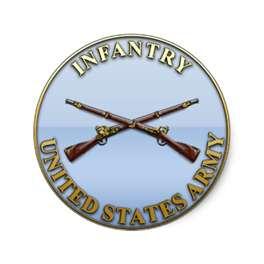

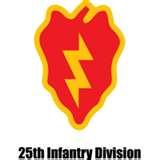

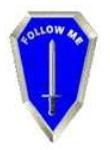
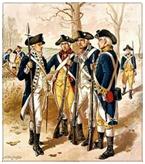
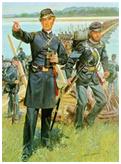
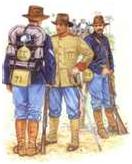



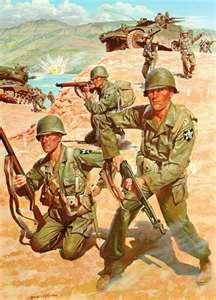

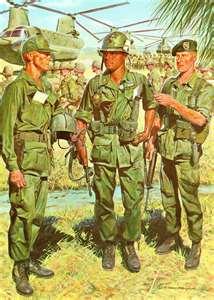
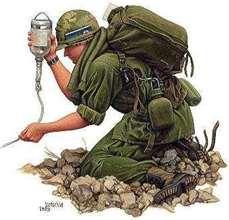
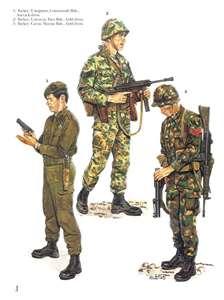


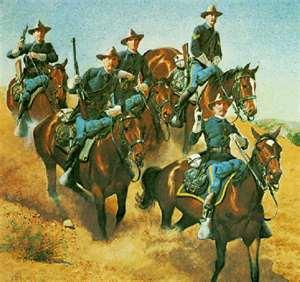
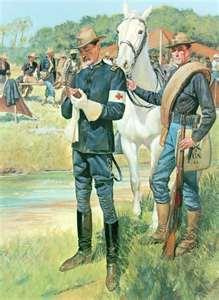



Infantry - Organizational configurations during the 20th Century
The US mobilized sixty-seven infantry divisions in World War II. They were the 1st-9th, 10th Mountain, 24th-38th, 40th-45th, 63rd, 65th, 66th, 69th-71st, 75th-81st, 83rd-91st, 92nd and 93rd Colored, 94th-100th, 102nd-104th, 106th, and Americal Infantry Divisions, 11th, 13th, 17th, 82nd, and 101st Airborne Divisions, and the 1st Cavalry Division, which was dismounted and utilized as infantry. Forty-two of the infantry divisions and four of the airborne divisions served in the ETO and MTO, the remainder served in the PTO.
The first permanent divisional organization in the U. S. Army appeared in World War I. Nine of these infantry divisions continued to exist through the 1920s and 1930s. These were "square" (two two-regiment brigades) organizations which were replaced, after considerable arguments and field tests, by a "triangular" organization of three regiments. By early 1942 the division was organized substantially the way it would be used in battle, with, in addition to its three infantry regiments, four artillery battalions (three twelve-tube 105mm light battalions and one twelve-tube 155mm howitzer medium battalion), a cavalry reconnaissance troop, and division service troops. A major general commanded the division. A brigadier general was assistant division commander and a second brigadier general was division artillery commander. Colonels commanded the infantry regiments and lieutenant colonels the battalions.
Note: Due to mobilization for World War I the army adopted its "square division" organization structure significantly increasing unit sizes from platoon up. In 1917 a fourth platoon was added to the company increasing its size to 256 officers and men, including six officers (a captain as commanding officer, a first lieutenant as executive officer, and two first lieutenants and two second lieutenants as platoon commanders). Enlisted strength became: three senior NCOs (first sergeant, supply sergeant, and mess sergeant), 12 sergeants, 33 corporals (one company clerk and 32 squad leaders with eight per platoon), eight specialists (four cooks and four mechanics), two buglers, 64 privates first class, and 128 privates. Of the 12 sergeants, while eight of them continued to serve as section leaders (with two in each platoon), the four senior ranking sergeants were assigned to a new position in each platoon headquarters as "assistant to platoon commander". This was the forerunner of the modern platoon sergeant slot created in 1943 (originally known in 1940 as the "platoon leader", as the officer was styled as the "platoon commander" until 1943) to provide an experienced senior NCO as an advisor and second-in-command to the officer commanding the platoon.
In mid-1944 (TO&E 7, dated 15 July 1943) the infantry division had 18 M3 105mm infantry howitzers, 36 M2 105mm howitzers, 12 M1 155mm howitzers, 5 half tracks, 13 M8 armored cars, 1,371 motor vehicles, and 10 light observation aircraft. Total personnel strength was 14,253.
The infantry regiment was organized with three battalions, twelve lettered companies (A-M, skipping J), an Infantry Cannon Company (first equipped with two half track-mounted 105mm howitzers and six half track-mounted 75mm howitzers or guns, and later with a towed short-barreled 105mm howitzer), an Antitank (AT) Company (initially with twelve 37mm and later nine 57mm AT guns), and a Service Company. The fourth company in each battalion (D, H, M) were heavy weapons companies with sustained fire heavy machine guns and mortars. The regiment and each battalion also had a H&H Company. The regimental H&H Company included a Intelligence and Reconnaissance Platoon, the battalion H&H company included an Ammunition and Pioneer (A&P, responsible for light engineering duties and for transporting ammunition forward to the line companies) Platoon and an AT Platoon (initially with four 37mm and later with 3 57mm AT guns).
In theory the US infantry regiment of World War II was a powerful, flexible organization and was the core of the infantry division. Unfortunately, poor personnel replacement planning in the early years of the war meant that after a few weeks of combat the regiment was chronically under strength. As an example, on 1 December 1944 the Third Army was under strength in infantrymen by the equivalent of 55 rifle companies. In effect, this meant that on average each of Third Army's infantry divisions were at two-thirds strength in their rifle companies.
After WWII - Vietnam
Sizes of the various units, Brigade, Battalion and Division in Vietnam differed greatly. Most companies operated with a field strength of 80-100 men excluding the 4th Heavy weapons platoon. TOE calls for a total strength of about 160 men. A brigade would include 3 manueauvering battalions, 1 mechanized unit, a squadron of tanks plus 1-2 field artillery batteries plus HHC groups.
The US mobilized sixty-seven infantry divisions in World War II. They were the 1st-9th, 10th Mountain, 24th-38th, 40th-45th, 63rd, 65th, 66th, 69th-71st, 75th-81st, 83rd-91st, 92nd and 93rd Colored, 94th-100th, 102nd-104th, 106th, and Americal Infantry Divisions, 11th, 13th, 17th, 82nd, and 101st Airborne Divisions, and the 1st Cavalry Division, which was dismounted and utilized as infantry. Forty-two of the infantry divisions and four of the airborne divisions served in the ETO and MTO, the remainder served in the PTO.
The first permanent divisional organization in the U. S. Army appeared in World War I. Nine of these infantry divisions continued to exist through the 1920s and 1930s. These were "square" (two two-regiment brigades) organizations which were replaced, after considerable arguments and field tests, by a "triangular" organization of three regiments. By early 1942 the division was organized substantially the way it would be used in battle, with, in addition to its three infantry regiments, four artillery battalions (three twelve-tube 105mm light battalions and one twelve-tube 155mm howitzer medium battalion), a cavalry reconnaissance troop, and division service troops. A major general commanded the division. A brigadier general was assistant division commander and a second brigadier general was division artillery commander. Colonels commanded the infantry regiments and lieutenant colonels the battalions.
Note: Due to mobilization for World War I the army adopted its "square division" organization structure significantly increasing unit sizes from platoon up. In 1917 a fourth platoon was added to the company increasing its size to 256 officers and men, including six officers (a captain as commanding officer, a first lieutenant as executive officer, and two first lieutenants and two second lieutenants as platoon commanders). Enlisted strength became: three senior NCOs (first sergeant, supply sergeant, and mess sergeant), 12 sergeants, 33 corporals (one company clerk and 32 squad leaders with eight per platoon), eight specialists (four cooks and four mechanics), two buglers, 64 privates first class, and 128 privates. Of the 12 sergeants, while eight of them continued to serve as section leaders (with two in each platoon), the four senior ranking sergeants were assigned to a new position in each platoon headquarters as "assistant to platoon commander". This was the forerunner of the modern platoon sergeant slot created in 1943 (originally known in 1940 as the "platoon leader", as the officer was styled as the "platoon commander" until 1943) to provide an experienced senior NCO as an advisor and second-in-command to the officer commanding the platoon.
In mid-1944 (TO&E 7, dated 15 July 1943) the infantry division had 18 M3 105mm infantry howitzers, 36 M2 105mm howitzers, 12 M1 155mm howitzers, 5 half tracks, 13 M8 armored cars, 1,371 motor vehicles, and 10 light observation aircraft. Total personnel strength was 14,253.
The infantry regiment was organized with three battalions, twelve lettered companies (A-M, skipping J), an Infantry Cannon Company (first equipped with two half track-mounted 105mm howitzers and six half track-mounted 75mm howitzers or guns, and later with a towed short-barreled 105mm howitzer), an Antitank (AT) Company (initially with twelve 37mm and later nine 57mm AT guns), and a Service Company. The fourth company in each battalion (D, H, M) were heavy weapons companies with sustained fire heavy machine guns and mortars. The regiment and each battalion also had a H&H Company. The regimental H&H Company included a Intelligence and Reconnaissance Platoon, the battalion H&H company included an Ammunition and Pioneer (A&P, responsible for light engineering duties and for transporting ammunition forward to the line companies) Platoon and an AT Platoon (initially with four 37mm and later with 3 57mm AT guns).
In theory the US infantry regiment of World War II was a powerful, flexible organization and was the core of the infantry division. Unfortunately, poor personnel replacement planning in the early years of the war meant that after a few weeks of combat the regiment was chronically under strength. As an example, on 1 December 1944 the Third Army was under strength in infantrymen by the equivalent of 55 rifle companies. In effect, this meant that on average each of Third Army's infantry divisions were at two-thirds strength in their rifle companies.
After WWII - Vietnam
Sizes of the various units, Brigade, Battalion and Division in Vietnam differed greatly. Most companies operated with a field strength of 80-100 men excluding the 4th Heavy weapons platoon. TOE calls for a total strength of about 160 men. A brigade would include 3 manueauvering battalions, 1 mechanized unit, a squadron of tanks plus 1-2 field artillery batteries plus HHC groups.



